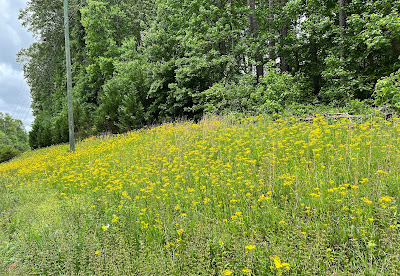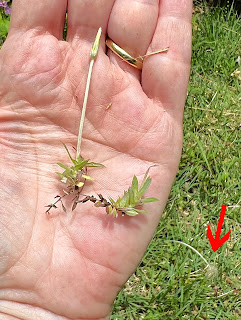The common plant name ‘ragwort’ is probably way too similar
to the word ragweed for comfort, but the ragworts are completely different plants –
and quite worthy of the garden. The word ‘wort’ is an old English term
for plant and ‘rag’ refers to the ragged edges of the leaves, thereby denoting
that this is a plant with ragged edges.
 |
| Packera anonyma |
The species in Georgia were previously in the genus Senecio but are now considered to be Packera. Several of them have the
common name golden ragwort or golden groundsel. The name ragwort was first applied to Senecio jacobaea (now Jacobaea vulgaris), a similar-looking plant native to Eurasia. It
is not unusual for our native plants to pick up common names from Old World
plants because that is what early explorers knew.
The seven species in Georgia are mostly perennial. The
species known as butterweed (Packera glabella)
is an early-blooming annual/biennial of moist floodplains where it can create
dense populations in early spring. However it is not limited to wild areas; it
has found my front lawn (which is moist) and spread happily there too. I leave
it for the small bees and early flower flies and then try to deadhead as much
as I can. Its thick but hollow stems make great spyglasses for toddlers too!
 |
| Packera glabella |
 |
| Packera tomentosa |
Another early blooming species is woolly ragwort (Packera tomentosa). I first saw this one
in the granite outcrop communities on Arabia Mountain. The pale, woolly
leaves are thick and distinctive.
 |
| Packera aurea at my house |
A mid-spring species is golden ragwort (Packera aurea). I have it in abundance
now but originally started with only 3 plants from a friend. It is evergreen
and blooms in shade; it is also deer resistant so I have happily moved it to
shady spots and given it away to friends and plant sales. Every spring it makes
beautiful sweeps of yellow flowers in April.
 |
| Packera anonyma on a roadside this week |
The late spring species gracing roadsides now is Small’s
ragwort (Packera anonyma). I love the
way it seems to come out of nowhere, spreading sunshine in large sweeps of
color. It grows happily in drier conditions than the equally prolific
butterweed. Bloom time and location are two key ways to distinguish the two
without leaving your car.
I have not encountered the other 3 species in Georgia, but
the one called roundleaf
groundsel (Packera obovata)
has similar foliage to P. aurea but
is more sun tolerant. The final two species are limited in range in Georgia;
the first one is Blue Ridge
ragwort (Packera millefolium).
It has highly dissected foliage and is found only in Rabun County on high
elevation rock outcrops. The second is balsam ragwort (Packera paupercula); it is found in moist prairies in Floyd County
and has foliage similar to P. anonyma.
My friends Richard and Teresa Ware of Floyd County also have photos of P.
crawfordii, a species of bog areas, that might be in NW Georgia.
I hope you’ll learn to appreciate ragwort and perhaps even
introduce a species or two to your garden. It’s hard to beat for dependable
spring blooms.















